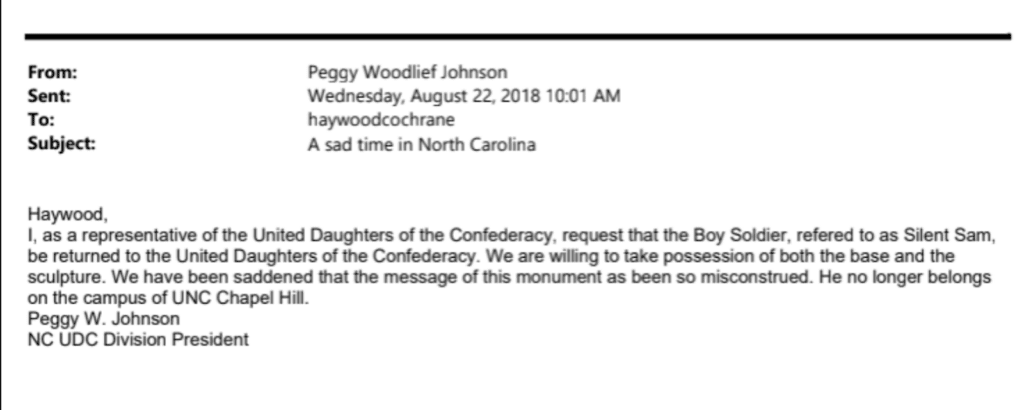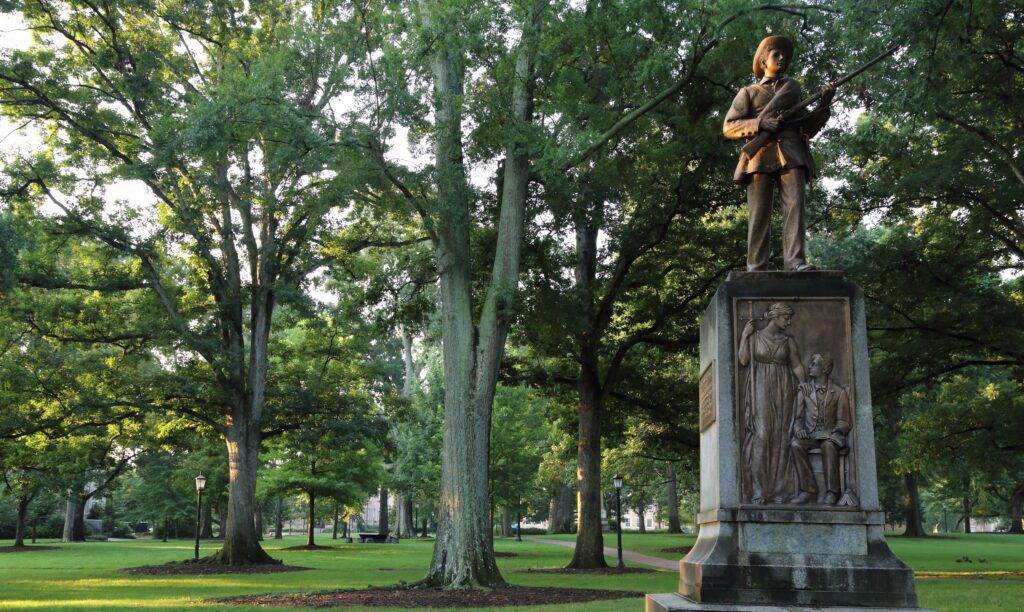For months now, UNC leaders have publicly wrung their hands over next steps for the Confederate monument known as “Silent Sam,” and suggested that only costly remedies will serve. But new correspondence suggests administrators have been sitting on a solution—one that’s both time- and cost-efficient—since the days just after the Confederate statue came down. I wrote about the scandal in an article for the Daily Beast, which you can also read below. Big thanks to Heather Redding, and happy holidays.
—Kali Holloway, director of the Make It Right Project
Why Is UNC-Chapel Hill Spending $5 Million to Protect a Racist Statue?
By Kali Holloway
On the night of Monday, August 20, anti-racist protesters toppled the monument to the Confederacy known as “Silent Sam” on the campus of the University of North Carolina at Chapel Hill (UNC). A week and a half later, school officials announced they planned to resurrect the racist marker.
Finally, earlier this month, the university’s board and Chancellor Carol Folt outlined their vision for relocating the statue. “Silent Sam” would be housed in a brand-new building that would cost the university $5.3 million to build and require $800,000 annually in upkeep.
But the university’s Board of Governors rejected that proposal, citing the steep price tag. They directed administrators to come up with a less expensive strategy. UNC officials reportedly have until March 15 to develop a new proposal for Silent Sam’s placement.
As it turns out, UNC administrators have been ignoring an option that wouldn’t cost the school a single penny: returning the statue to the group that erected it originally—and requested its return months ago.
An email reviewed by the Daily Beast and reported on there for the first time shows that two days after the August toppling of “Silent Sam,” the United Daughters of the Confederacy (UDC)—the group that put up the marker back in 1913—asked that the felled Confederate monument be returned to them. The letter has come to light as a result of a FOIA request filed by anti-racist activist and Hillsborough Progressives Taking Action organizer Heather Redding.
“I, as a representative of the United Daughters of the Confederacy, request that the Boy Soldier, referred to as Silent Sam, be returned to the United Daughters of the Confederacy,” wrote Peggy Johnson, then-president of the UDC’s North Carolina Division, to UNC Board of Trustees Chair Haywood D. Cochrane Jr. “We are willing to take possession of both the base and sculpture…He no longer belongs on the campus of UNC Chapel Hill.”
 Johnson’s exact plans for the statue were not disclosed. FOIA documents show no indication that Cochrane responded to her email.
Johnson’s exact plans for the statue were not disclosed. FOIA documents show no indication that Cochrane responded to her email.
Despite the UDC’s offer, officials at UNC-Chapel Hill have insisted the monument must be re-erected on campus to comply with a North Carolina law that protects markers that glorify the Confederate army. That legislation was passed by state GOP lawmakers in 2015 as a bulwark against attempts to remove Confederate iconography following the massacre of nine black churchgoers in Charleston, South Carolina, and a successful effort to remove the name of a Confederate soldier and KKK member from a UNC dormitory.
At the 1913 dedication ceremony for “Silent Sam,” UNC honorary degree holder and invited speaker Julian Carr explicitly praised the UDC’s newly erected monument for its celebration of racist terror and white supremacy. In addition to thanking the Confederate soldiers who formed the Ku Klux Klan during Reconstruction, “sav[ing] the very life of the Anglo Saxon race in the South,” Carr also bragged about having “horse-whipped a negro wench until her skirts hung in shreds” near the site of the statue.
The UDC’s offer to take Silent Sam back is a rare example of the group’s willingness to have its racist monuments be removed. (Curiously, correspondence sent a day later to the UNC Board of Governors by the Sons of Confederate Veterans, another neo-Confederate heritage group, demands the statue be returned to its pedestal on behalf of both groups.) In numerous cases, as jurisdictions have announced plans to remove or relocate Confederate markers, the UDC has filed lawsuits to ensure that those monuments remain standing.
A UDC suit against San Antonio lawmakers who in 2017 removed a Texas Confederate statue is still winding its way through the courts; in Franklin, Tennessee, a local UDC chapter threatened to sue town officials who plan to erect black historical markers near a UDC Confederate statue. The group, which in 1926 erected a North Carolina monument to honor the Ku Klux Klan, is responsible for the majority of Confederate markers across the country and far beyond the boundaries of the former Confederacy, including in sites such as Seattle, Washington and Brooklyn, New York.
The Durham-based Herald-Sun notes that UNC’s insistence on reinstalling the “Silent Sam” Confederate monument is likely less about following the letter of the law than it is intended to keep Republican legislators, who wield power over school administrators, happy. “They appoint UNC’s governing bodies,” the paper points out in an opinion piece, “and have championed voter suppression, racially based gerrymandering of political districts, and the privatization of public education, going so far as to legally create all white charter school districts for wealthy white communities, in addition to maintaining the ‘Silent Sam’ statue.”
That probably also accounts for UNC leaders’ longstanding inaction related to Silent Sam, which has been a target of protest for more than half a century. A 1965 student letter to the campus newspaper noted Silent Sam was erected “to associate a fictitious ‘honor’ with the darkest blot on American history—the fight of southern racists to keep the Negro peoples in a position of debased subservience.”
Days after the 1968 murder of Martin Luther King Jr., black UNC students protested Silent Sam by defacing the statue with paint. In recent years, faculty from UNC’s Departments of Art, Geography, and Communications and School of Law have written open letters asking that the statue be removed, students have held numerous peaceful demonstrations at the statue, and local anti-racist activists have filed petitions and made various other legal efforts to bring the statue down.
The university responded by assigning plainclothes police officers to infiltrate student activist circles and spy on their actions, and leaked emails revealed a UNC Board of Trustees member had described protesting students as “entitled wimps.” As UNC investigated its own students and generally did little else to address the Silent Sam issue, neo-Confederates and other white supremacists rallied at the site and issued racist online threats against student activists. Those groups have been a consistent presence on campus since the statue was taken down, proving Silent Sam is a threat to public safety, particularly for black and other students of color.
In response to the university’s promise to re-erect the racist symbol, teaching assistants had threatened a grade strike, but have relented for the time being, promising to revisit the issue in the spring semester. Other critics of the plan pointed out that the funds for the new Silent Sam building could be used to update buildings that have seen better days, to improve student services, or to help with financial aid packages.
An op-ed in UNC’s student newspaper, the Daily Tar Heel, noted that Latinx student organizations had been repeatedly told over years that UNC school couldn’t provide meeting space, yet the university seemed to have no problem coming up with millions to construct a building for Silent Sam. “It seems UNC is more willing to spend money on a racist relic of the past than students who attend this school,” wrote the paper’s Editorial Board.
What’s more, eight historically black fraternities and sororities are housed near the proposed Silent Sam space. UNC, which spent nearly $400,000 last year on security for Silent Sam, shells out staggering amounts of money to keep a racist monument safe, but can’t be bothered to ensure its POC students aren’t traumatized by an ode to white power and anti-black racist violence.
This article was originally published on the Daily Beast.
Kali Holloway is the director of Make It Right, a new national campaign to take down Confederate monuments and tell the truth about history. Her writing has appeared in Salon, The Guardian, TIME, AlterNet, Truthdig, Huffington Post, The National Memo, Jezebel, Raw Story and numerous other outlets.
Article Image: “Silent” by Don McCullough, CC BY 2.0, Flickr

